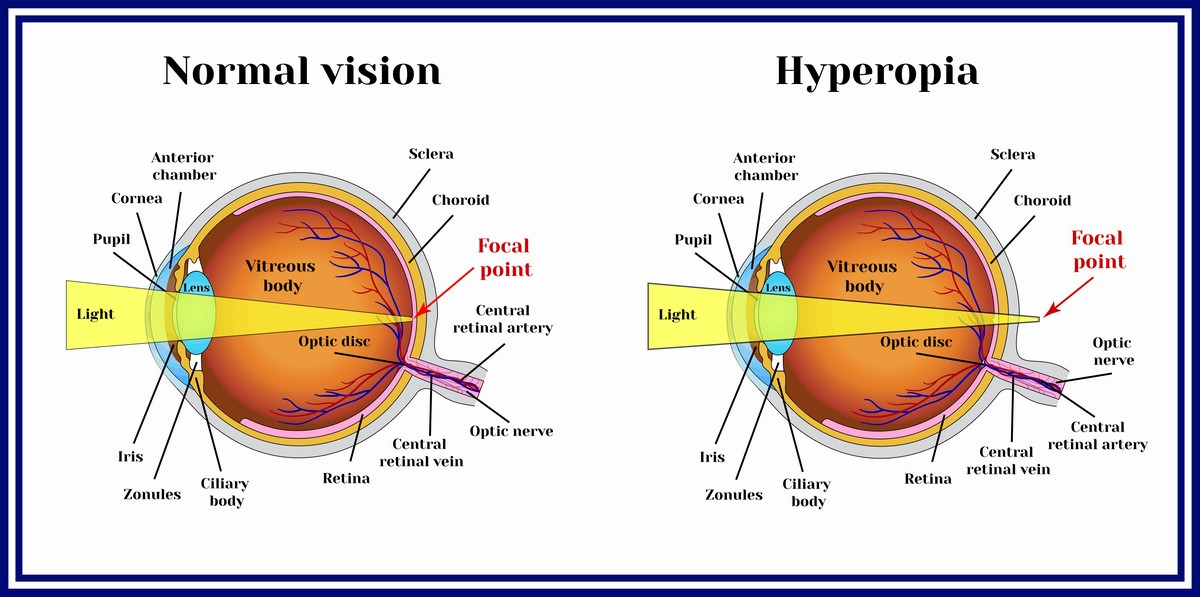What is Farsightedness and How Can Contacts Correct It?

The medical term used by eye care professionals for farsightedness is hyperopia. The American Academy of Ophthalmology estimates 8.4% of the US population over age 40 have hyperopia.
Farsightedness and nearsightedness are both refractive errors. Nowadays, refractive errors are easy to correct with the help of corrective lenses.
Your optometrist may recommend glasses, but you can also choose to get contact lenses in most cases. Your doctor will help you to decide which is best for you.
What is farsightedness? How much do you know about this condition? Not a lot? Then read on to find out more about farsightedness and how to correct it.
What Is Farsightedness?
Farsightedness, or hyperopia, is a common refractive error. It happens when the eye is shorter than normal. The lens of the eye focuses an image on the back of the eye, called the retina. The retina is covered with photoreceptor cells. It converts light into neural signals to be sent to the brain. When the eye is shorter than normal, the image focuses behind the retina. As a result, the lens has to work harder to focus the image on the retina.
The condition can vary in severity. Babies and children are often farsighted. Most children will grow out of it as their eyes grow and develop.
Your eye care professional may not explicitly tell you whether or not you are farsighted or nearsighted. When you look at your prescription, you may notice some foreign numbers and symbols. If your prescription begins with a plus sign, you're farsighted. The other numbers will refer to the level of vision correction that your eyes need.
Symptoms of Farsightedness
If you're farsighted, you may notice that you can better see objects at a distance than when they are close to you. In teen and young adult years, many people may not notice any signs of farsightedness.
But with age, the symptoms may become more extreme. You may even notice that distant objects are becoming blurry.
People generally first notice their farsightedness while reading. Books, newspapers and any other prints may become difficult to read. Early detection allows you to begin the process of vision correction.
Don’t Confuse Farsightedness With Presbyopia

A variety of vision problems result in quite similar symptoms. Presbyopia is a condition which results in blurred vision up close and clear vision at a distance.
What's the difference between hyperopia (or farsightedness) and presbyopia? Hyperopia is caused by misshapen eyeballs, while presbyopia occurs when your eye muscles change.
Age is a major determinant of presbyopia. If you're over the age of 40, you may start noticing blurred vision when you read or look at nearby objects. This affects everyone. Really, everyone!
As you age, the lens loses its elasticity. You'll notice that your eyes don't work the way they did when you were younger. Such is the natural aging process.
It's completely normal, and also easily corrected. But presbyopia requires a different type of lens than those used to correct farsightedness.
Why Am I Farsighted?
Farsightedness has many different causes. The most common cause of farsightedness is genetics.
That's right, you can blame your parents for your poor vision. Although, they may still make fun of you if you bring this up at the next family dinner!
Contact Lenses to Correct Farsightedness

Some people cringe at the idea of wearing corrective lenses because they imagine a nerdy pair of glasses. Yet, others may find that glasses are an appealing vision correction tool.
Luckily, correcting farsightedness is easy. You'll have several different options that you can discuss with your eye care professional.
Of course, glasses will be the easiest way to correct your vision. But contacts are equally easy. Spherical contact lenses are often used to correct farsightedness.
The decision between prescription glasses and contact lenses is a matter of personal preference. You may prefer to wear one or the other when you read, work on your computer, or do other close-up work.
You will need to weigh the pros and cons of both options before you decide if contacts are right for you.
Choosing the Right Contacts

You may decide contacts are right for you. After all, they're safe and easy to use. However, you may have a hard time deciding which ones to choose.
You should discuss your options with your eye care professional.
Here are some of the factors you'll need to consider:
- The length of wear: Different types of contact lenses can be worn for varying lengths of time. Some lenses are suitable for several days of wear. Others are suitable for one day only. Some can be worn overnight. Some can't.
- Rigid or soft: There are pros and cons for each type. Soft lenses are more comfortable and easy to wear. Rigid lenses resist deposit buildup and provide sharper acuity.
- Your needs: Contacts are available for a variety of vision needs. You may also have a combination of more than one eye condition. That’s why you will need to get guidance from your optometrist to help you make a decision.
If you're new to contact lenses, you may feel overwhelmed. It’s important to take your time to understand your options.
Other Treatment Options
Some people may not want to wear glasses or contacts so often. If this sounds like you, you may want to look into surgery.
The surgery itself is simple and doesn't take very long. It involves the use of laser technology and small incisions to correct the cornea. This could greatly or completely eliminate your need for corrective lenses. An ophthalmologist will perform the surgery. These procedures can be rather expensive, though. And your insurance plan may not cover the procedure.
You should check with an insurance agent before you opt to undergo corrective surgery.
Farsightedness and You

We hope that you now have a better understanding of what farsightedness is, its causes, and the accompanying symptoms. You have several options to choose from to correct this vision problem.
Contacts are an effective and easy way to get perfect vision in the face of hyperopia. They are cost-effective and quite convenient. So if you're shopping for contact lenses, then you might want to check out the lenses we offer. We provide quality brands at reasonable prices. Get your contacts today!